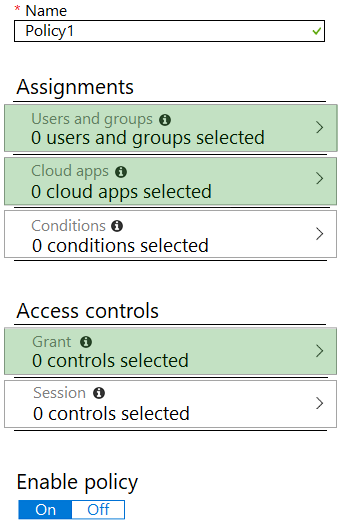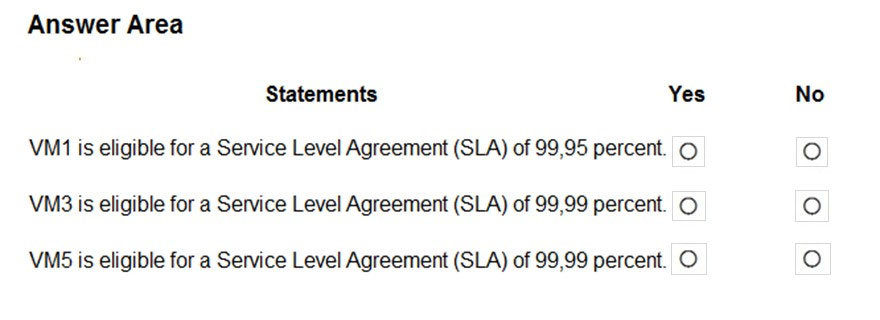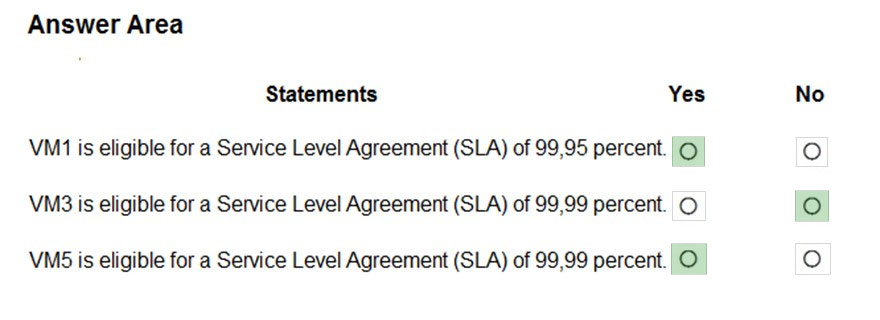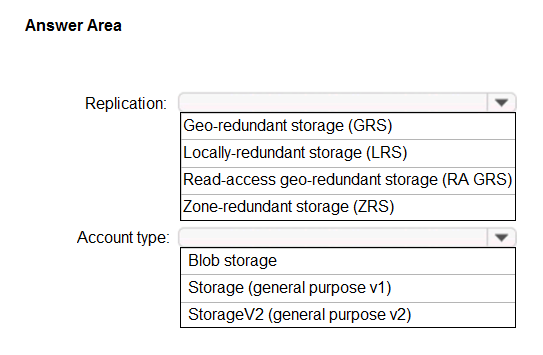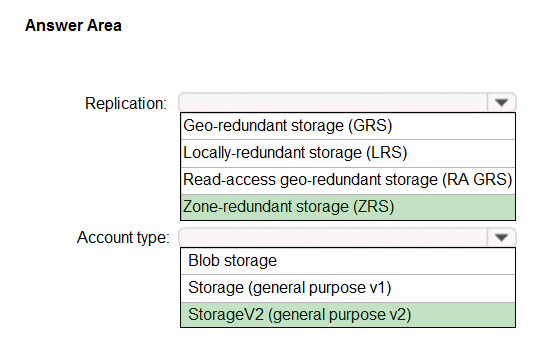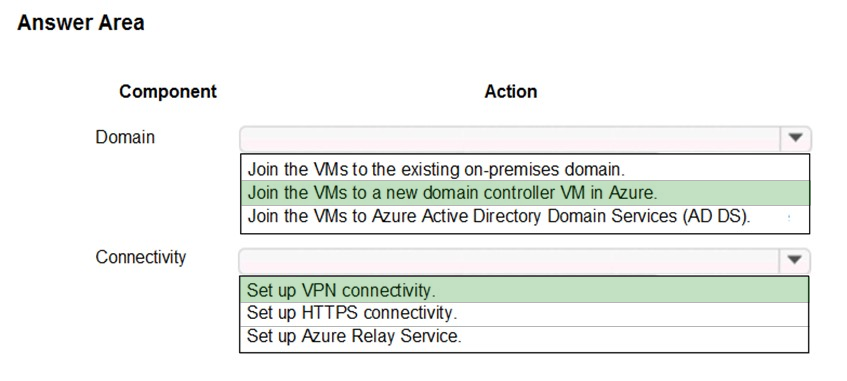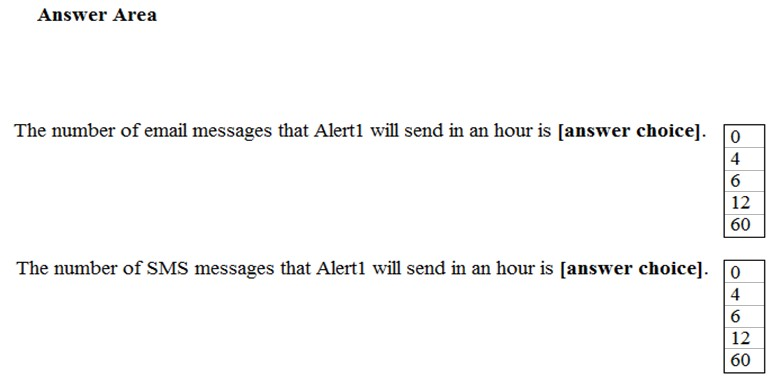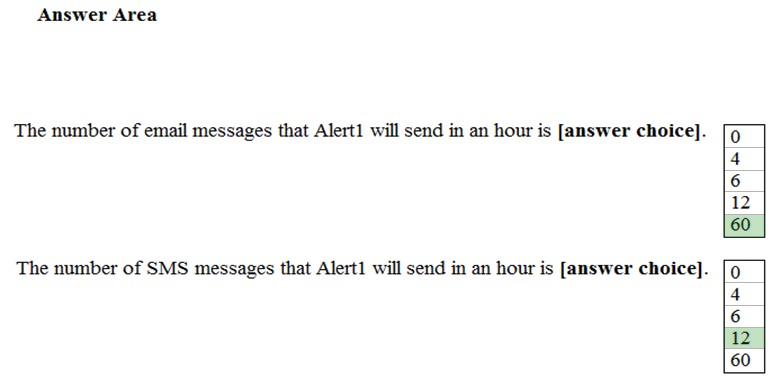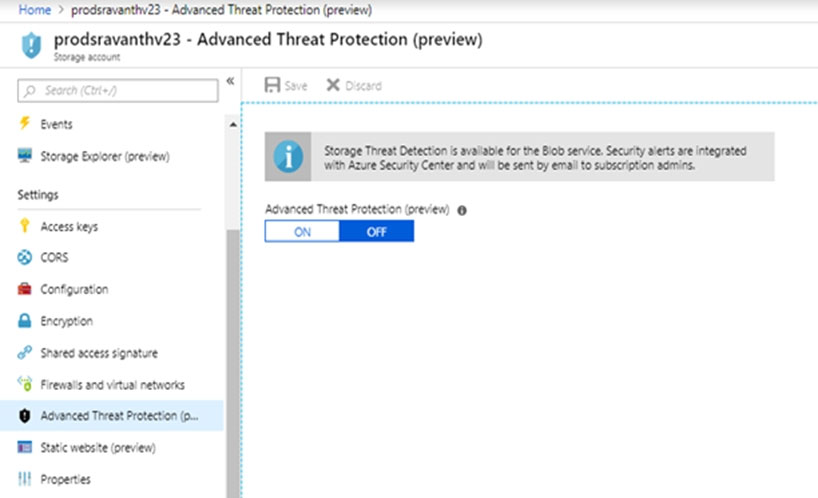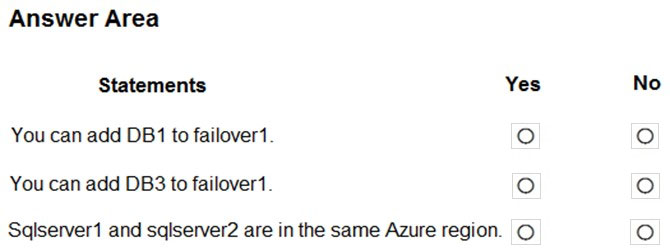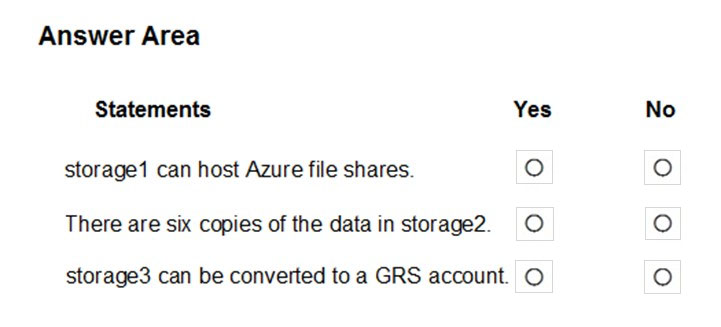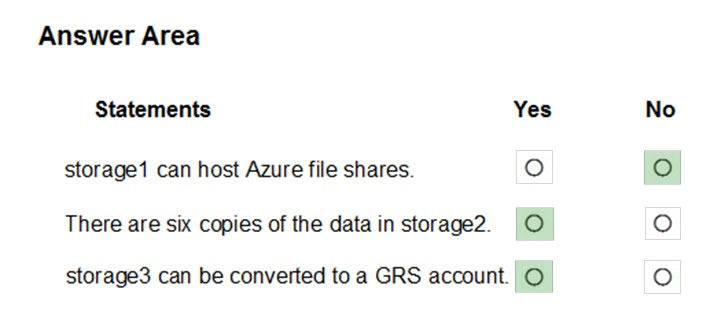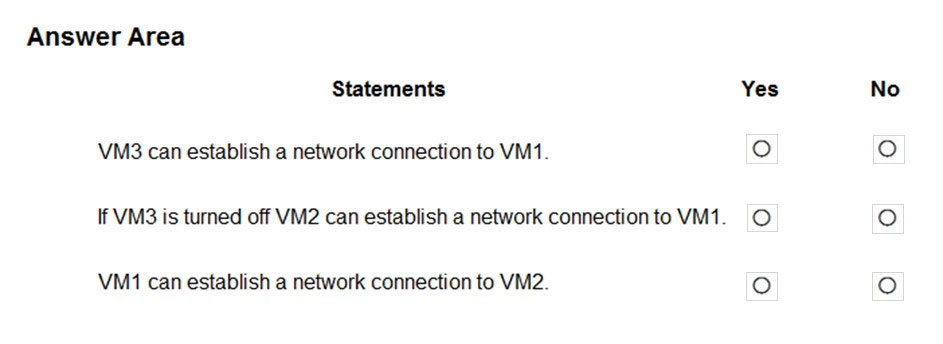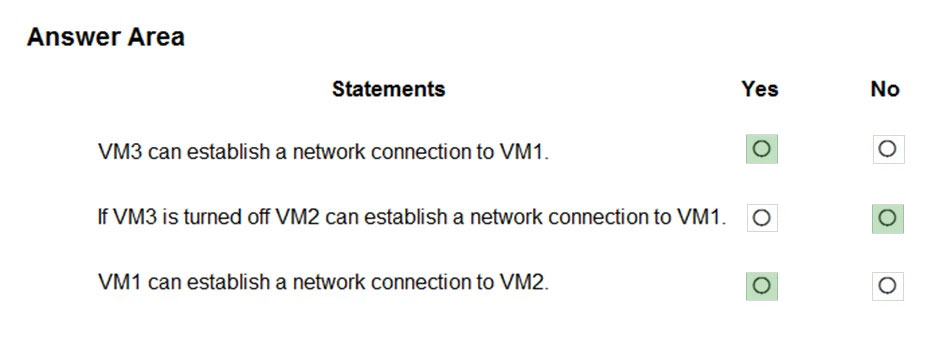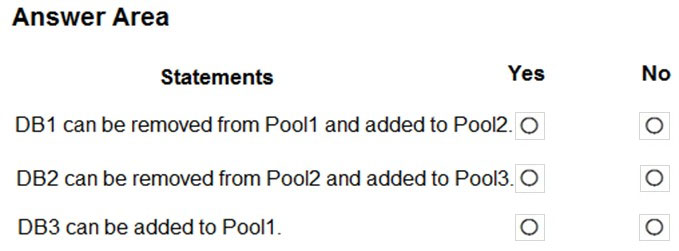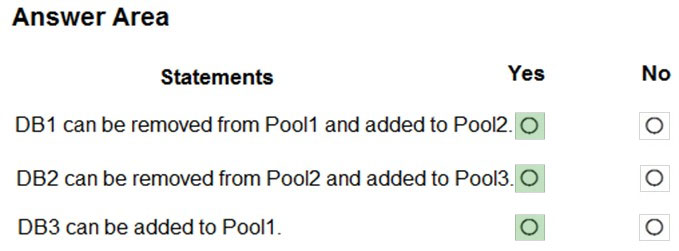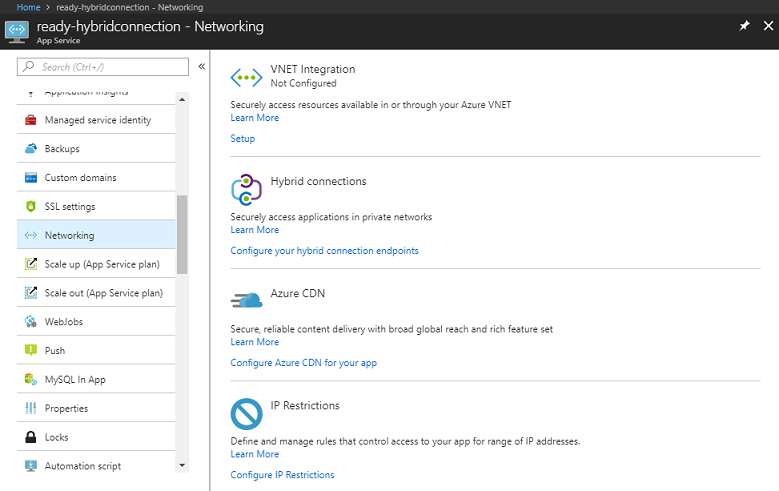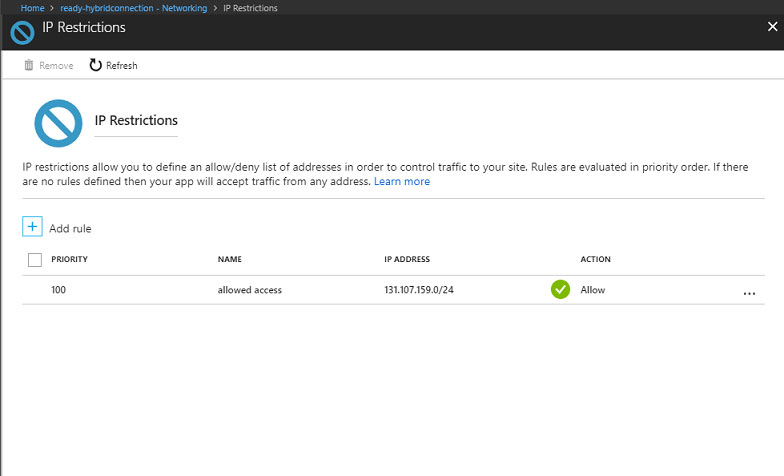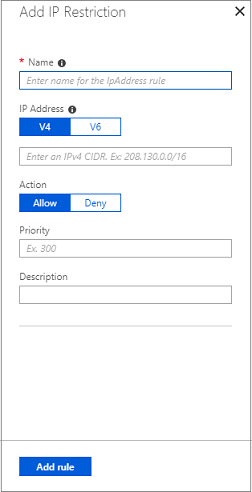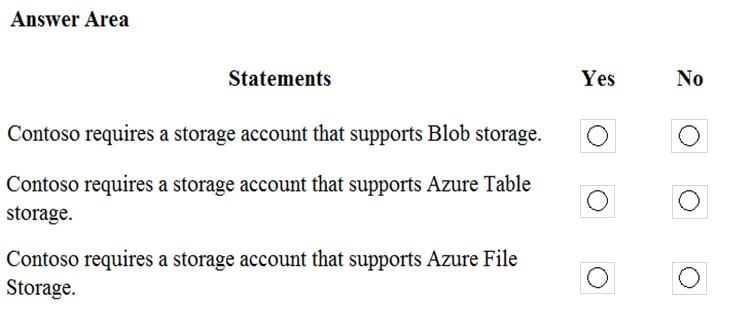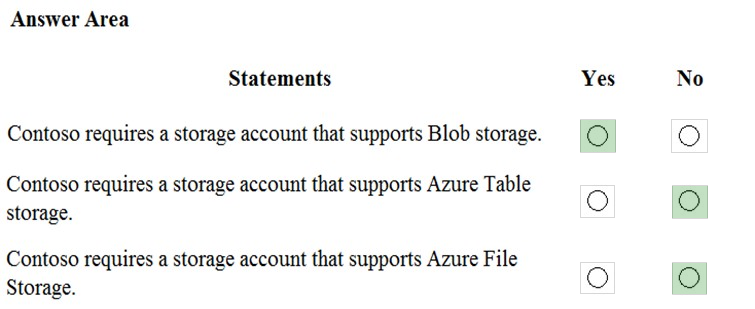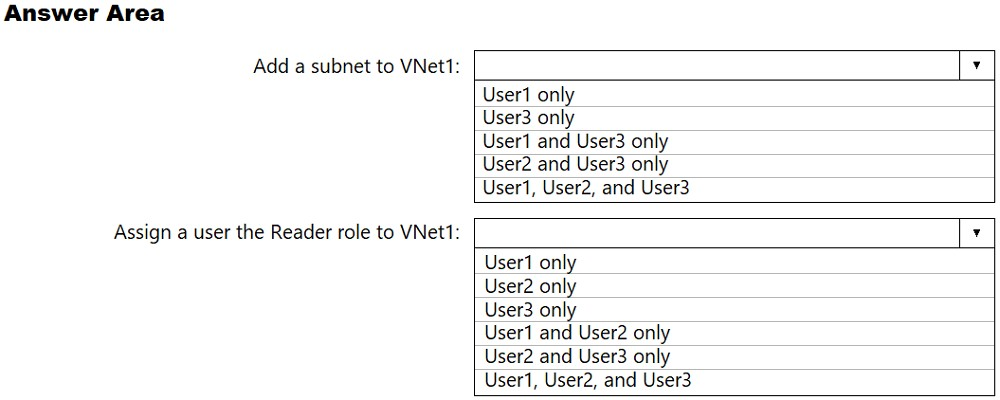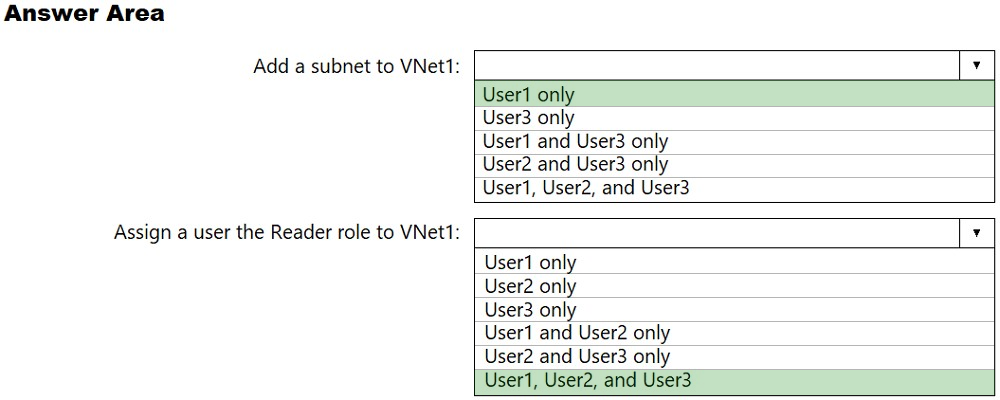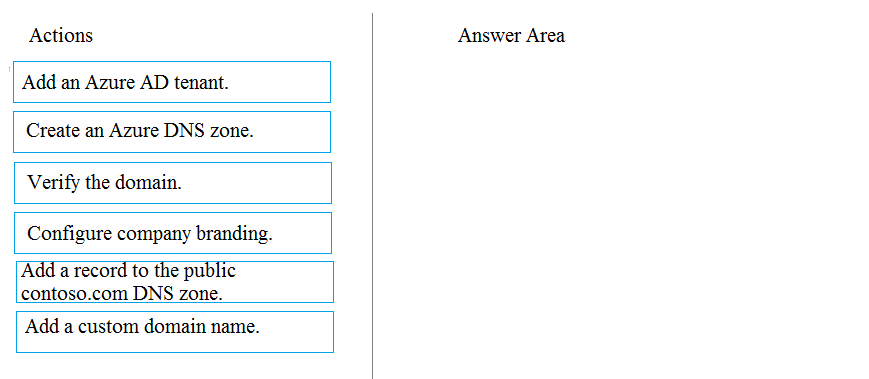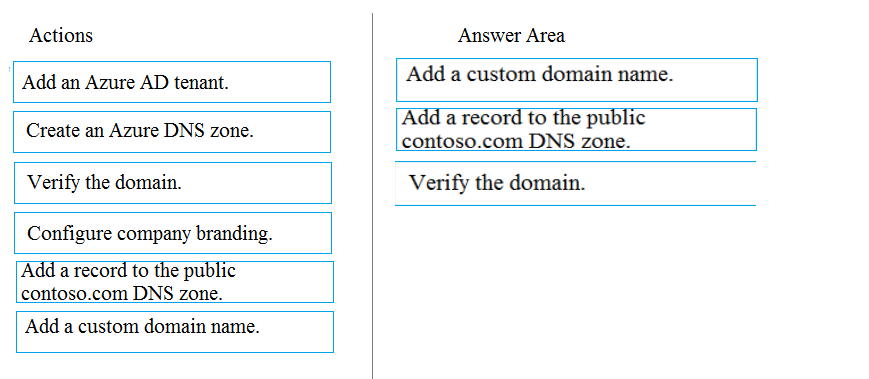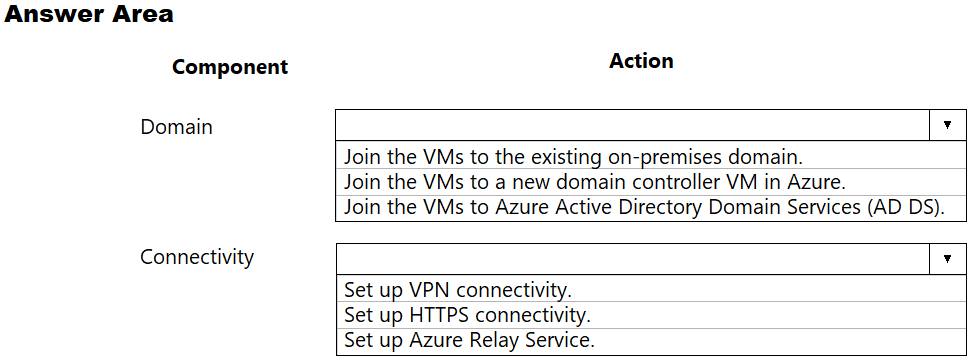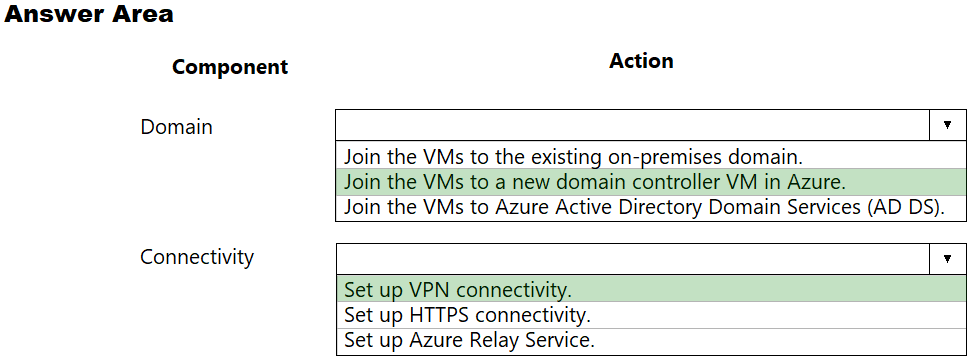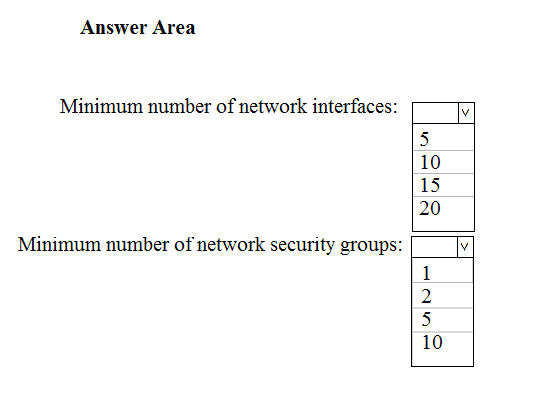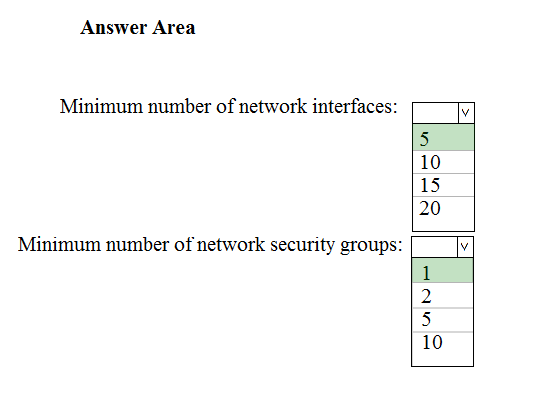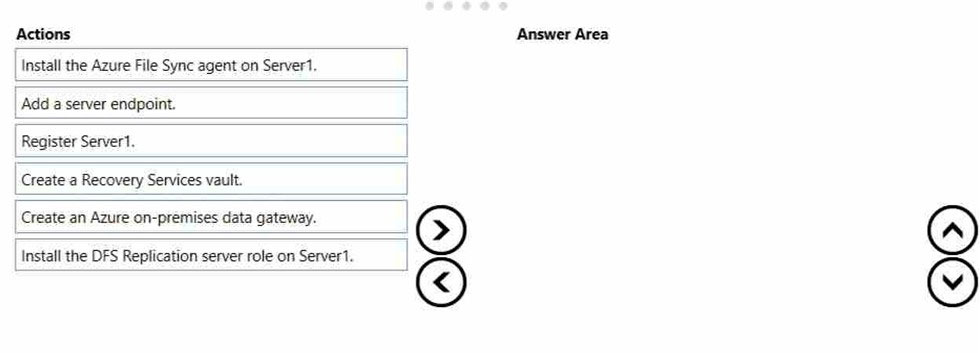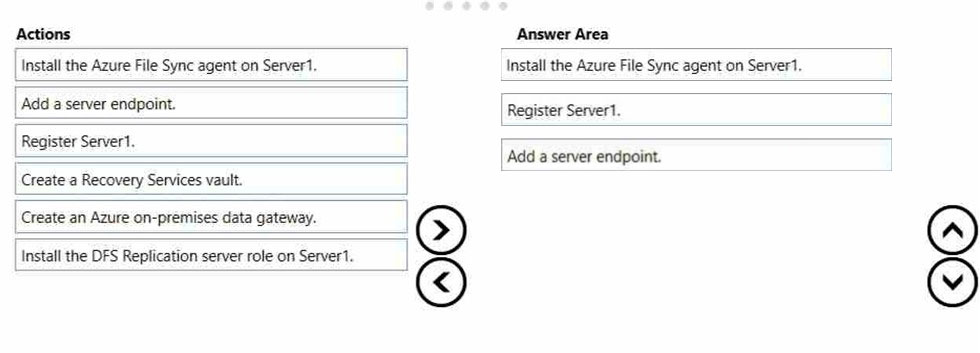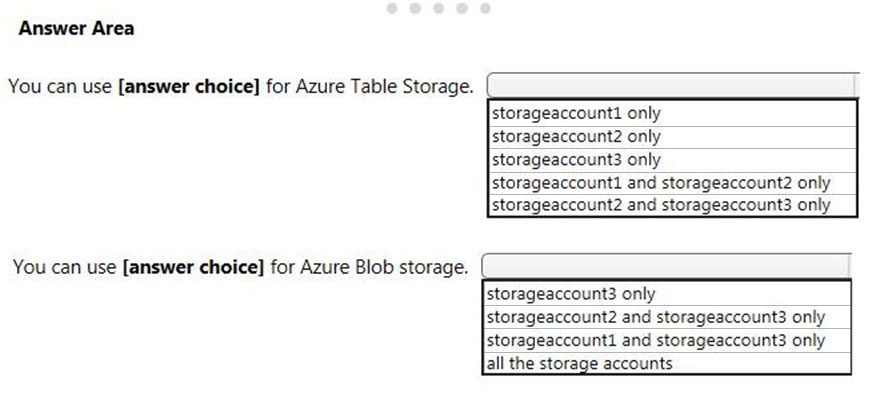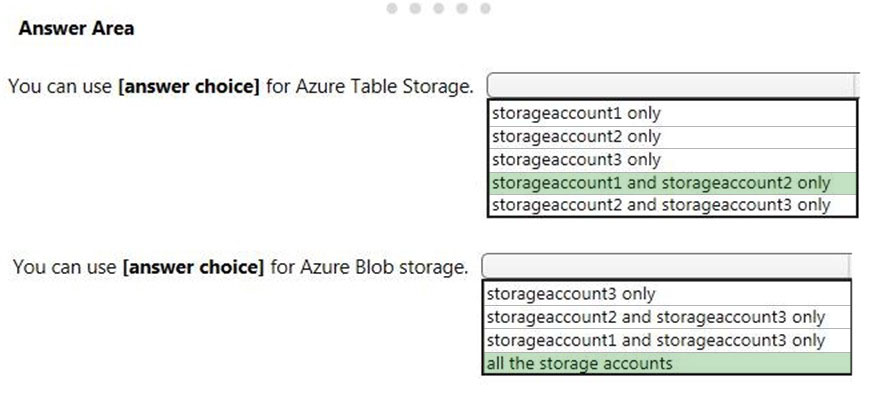AZ-303 Practice Questions Free – 50 Exam-Style Questions to Sharpen Your Skills
Are you preparing for the AZ-303 certification exam? Kickstart your success with our AZ-303 Practice Questions Free – a carefully selected set of 50 real exam-style questions to help you test your knowledge and identify areas for improvement.
Practicing with AZ-303 practice questions free gives you a powerful edge by allowing you to:
- Understand the exam structure and question formats
- Discover your strong and weak areas
- Build the confidence you need for test day success
Below, you will find 50 free AZ-303 practice questions designed to match the real exam in both difficulty and topic coverage. They’re ideal for self-assessment or final review. You can click on each Question to explore the details.
HOTSPOT - You have an Azure Active Directory (Azure AD) tenant. You need to create a conditional access policy that requires all users to use multi-factor authentication when they access the Azure portal. Which three settings should you configure? To answer, select the appropriate settings in the answer area. NOTE: Each correct selection is worth one point. Hot Area:
HOTSPOT - You have an Azure subscription named Subscription1. Subscription1 contains the virtual machines in the following table.Subscription1 contains a virtual network named VNet1 that has the subnets in the following table.
VM3 has a network adapter named NIC3. IP forwarding is enabled on NIC3. Routing is enabled on VM3. You create a route table named RT1 that contains the routes in the following table.
You apply RT1 to Subnet1 and Subnet2. For each of the following statements, select Yes if the statement is true. Otherwise, select No. NOTE: Each correct selection is worth one point. Hot Area:
HOTSPOT - You have an Azure subscription that contains the resource groups shown in the following table.RG1 contains the virtual machines shown in the following table.
RG2 contains the virtual machines shown in the following table.
All the virtual machines are configured to use premium disks and are accessible from the Internet. VM1 and VM2 are in an availability set named AVSET1. VM3 and VM4 are in the same availability zone and are in an availability set named AVSET2. VM5 and VM6 are in different availability zones. For each of the following statements, select Yes if the statement is true. Otherwise, select No. NOTE: Each correct selection is worth one point. Hot Area:
HOTSPOT - You plan to create an Azure Storage account in the Azure region of East US 2. You need to create a storage account that meets the following requirements: ✑ Replicates synchronously ✑ Remains available if a single data center in the region fails How should you configure the storage account? To answer, select the appropriate options in the answer area. NOTE: Each correct selection is worth one point. Hot Area:
HOTSPOT - A company runs multiple Windows virtual machines (VMs) in Azure. The IT operations department wants to apply the same policies as they have for on-premises VMs to the VMs running in Azure, including domain administrator permissions and schema extensions. You need to recommend a solution for the hybrid scenario that minimizes the amount of maintenance required. What should you recommend? To answer, select the appropriate options in the answer area. NOTE: Each correct selection is worth one point. Hot Area:
You have an Azure Active Directory (Azure AD) tenant. All administrators must enter a verification code to access the Azure portal. You need to ensure that the administrators can access the Azure portal only from your on-premises network. What should you configure?
A. the default for all the roles in Azure AD Privileged Identity Management
B. an Azure AD Identity Protection user risk policy
C. an Azure AD Identity Protection sign-in risk policy
D. the multi-factor authentication service settings
SIMULATION - Click to expand each objective. To connect to the Azure portal, type https://portal.azure.com in the browser address bar.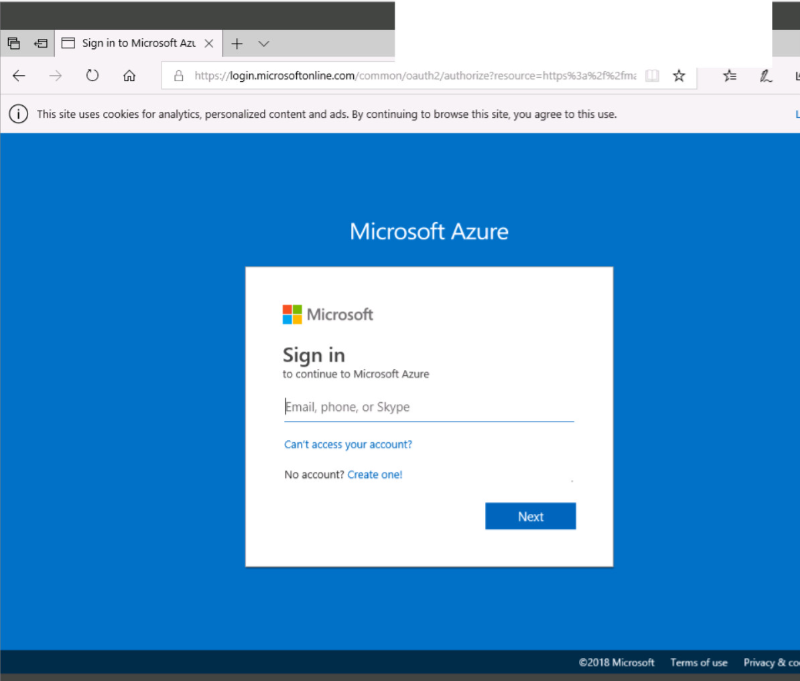
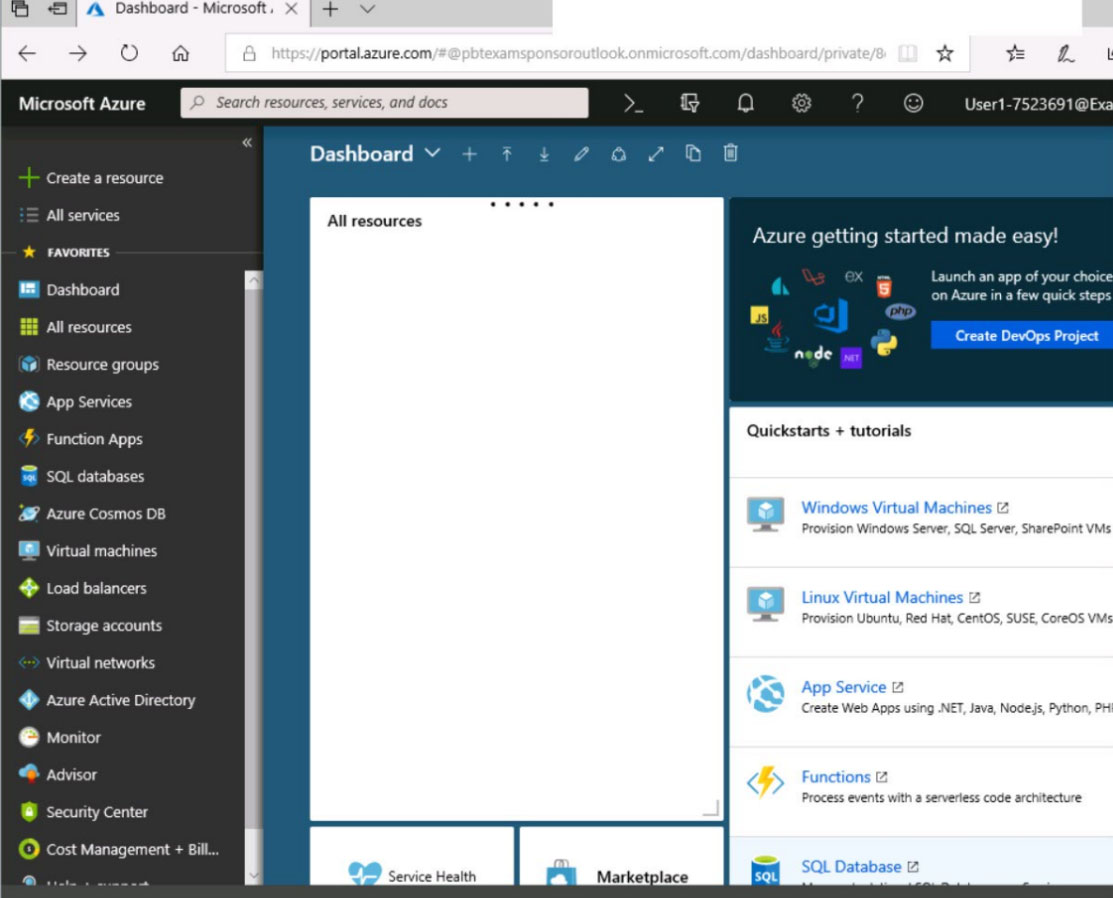
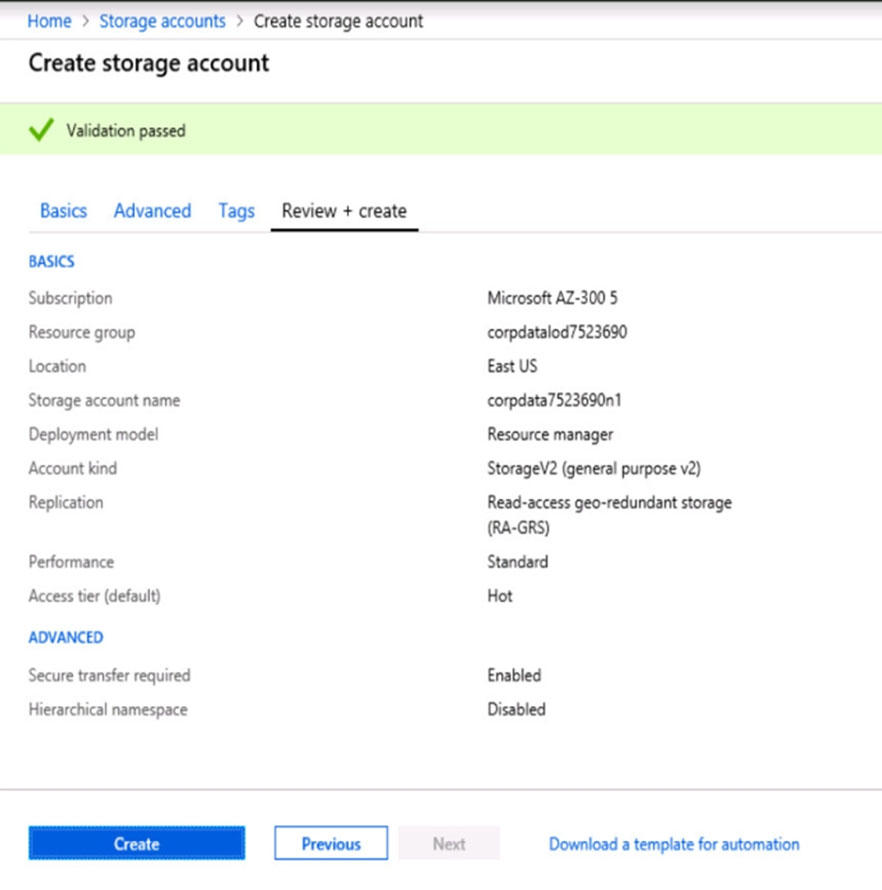
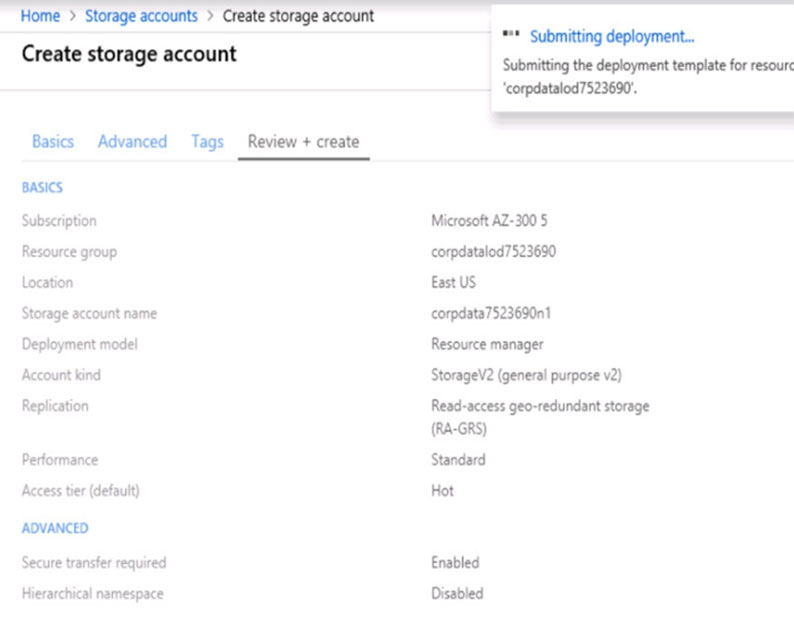

When you are finished performing all the tasks, click the `˜Next' button. Note that you cannot return to the lab once you click the `˜Next' button. Scoring occur in the background while you complete the rest of the exam. Overview - The following section of the exam is a lab. In this section, you will perform a set of tasks in a live environment. While most functionality will be available to you as it would be in a live environment, some functionality (e.g., copy and paste, ability to navigate to external websites) will not be possible by design. Scoring is based on the outcome of performing the tasks stated in the lab. In other words, it doesn't matter how you accomplish the task, if you successfully perform it, you will earn credit for that task. Labs are not timed separately, and this exam may have more than one lab that you must complete. You can use as much time as you would like to complete each lab. But, you should manage your time appropriately to ensure that you are able to complete the lab(s) and all other sections of the exam in the time provided. Please note that once you submit your work by clicking the Next button within a lab, you will NOT be able to return to the lab. To start the lab - You may start the lab by clicking the Next button. Your on-premises network uses an IP address range of 131.107.2.0 to 131.107.2.255. You need to ensure that only devices from the on-premises network can connect to the rg1lod8322490n1 storage account. What should you do from the Azure portal?
Your company has an Azure subscription. You enable multi-factor authentication (MFA) for all users. The company's help desk reports an increase in calls from users who receive MFA requests while they work from the company's main office. You need to prevent the users from receiving MFA requests when they sign in from the main office. What should you do?
A. From Conditional access in Azure Active Directory (Azure AD), create a named location.
B. From the MFA service settings, create a trusted IP range.
C. From Conditional access in Azure Active Directory (Azure AD), create a custom control.
D. From Azure Active Directory (Azure AD), configure organizational relationships.
Note: This question is part of series of questions that present the same scenario. Each question in the series contains a unique solution that might meet the stated goals. Some question sets might have more than one correct solution, while others might not have a correct solution. After you answer a question in this section, you will NOT be able to return to it. As a result, these questions will not appear in the review screen. You have an Azure Active Directory (Azure AD) tenant named contoso.com. A user named Admin1 attempts to create an access review from the Azure Active Directory admin center and discovers that the Access reviews settings are unavailable. Admin1 discovers that all the other Identity Governance settings are available. Admin1 is assigned the User administrator, Compliance administrator, and Security administrator roles. You need to ensure that Admin1 can create access reviews in contoso.com. Solution: You assign the Service administrator role to Admin1. Does this meet the goal?
A. Yes
B. No
An administrator plans to create a function app in Azure that will have the following settings: ✑ Runtime stack: .NET Core ✑ Operating System: Linux ✑ Plan type: Consumption ✑ Enable Application Insights: Yes You need to ensure that you can back up the function app. Which settings should you recommend changing before creating the function app?
A. Runtime stack
B. Enable Application Insights
C. Operating System
D. Plan type
Your company has the groups shown in the following table.The company has an Azure subscription that contains an Azure Active Directory (Azure AD) tenant named contoso.com. An administrator named Admin1 attempts to enable Enterprise State Roaming for all the users in the Managers group. Admin1 reports that the options for Enterprise State Roaming are unavailable from Azure AD. You verify that Admin1 is assigned the Global administrator role. You need to ensure that Admin1 can enable Enterprise State Roaming. What should you do?
A. Enforce Azure Multi-Factor Authentication (MFA) for Admin1.
B. Purchase an Azure AD Premium P1 license for each user in the Managers group.
C. Assign an Azure AD Privileged Identity Management (PIM) role to Admin1.
D. Purchase an Azure Rights Management (Azure RMS) license for each user in the Managers group.
HOTSPOT - You have an Azure subscription named Subscription1. In Subscription1, you create an alert rule named Alert1. The Alert1 action group is configured as shown in the following exhibit.Alert1 alert criteria is triggered every minute. Use the drop-down menus to select the answer choice that completes each statement based on the information presented in the graphic. NOTE: Each correct selection is worth one point. Hot Area:
After you answer a question in this section, you will NOT be able to return to it. As a result, these questions will not appear in the review screen. You manage an Active Directory domain named contoso.local. You install Azure AD Connect and connect to an Azure Active Directory (Azure AD) tenant named contoso.com without syncing any accounts. You need to ensure that only users who have a UPN suffix of contoso.com in the contoso.local domain sync to Azure AD. Solution: You use the Synchronization Service Manager to modify the Active Directory Domain Services (AD DS) Connector. Does this meet the goal?
A. Yes
B. No
You have an Azure subscription that contains the storage accounts shown in the following table.You enable Storage Advanced Threat Protection (ATP) for all the storage accounts. You need to identify which storage accounts will generate Storage ATP alerts. Which two storage accounts should you identify? Each correct answer presents part of the solution. NOTE: Each correct selection is worth one point.
A. storagecontoso1
B. storagecontoso2
C. storagecontoso3
D. storagecontoso4
E. storagecontoso5
You have an Azure web app that runs in a Premium App Service plan. Developers plan to update the app weekly. You need to ensure that the app can be switched from the current version to the new version. The solution must meet the following requirements: ✑ Provide the developers with the ability to test the app in Azure prior to switching versions. Testing must use the same app instance. ✑ Ensure that the app version can be rolled back. ✑ Minimize downtime. What should you do?
A. Create a deployment slot.
B. Copy the App Service plan.
C. Add an instance of the app to the scale set.
D. Create an Azure Active Directory (Azure AD) enterprise application.
You need to move the blueprint files to Azure. What should you do?
A. Use the Azure Import/Export service.
B. Generate a shared access signature (SAS). Map a drive, and then copy the files by using File Explorer.
C. Use Azure Storage Explorer to copy the files.
D. Generate an access key. Map a drive, and then copy the files by using File Explorer.
You create a new Azure subscription. You create a resource group named RG1. In RG1, you create the resources shown in the following table.You need to configure an encrypted tunnel between your on-premises network and VNET1. Which two additional resources should you create in Azure? Each correct answer presents part of the solution. NOTE: Each correct selection is worth one point.
A. a site-to-site connection
B. a VPN gateway
C. a VNet-to- VNet connection
D. a local network gateway
E. a point-to-site configuration
HOTSPOT - You need to design an authentication solution that will integrate on-premises Active Directory and Azure Active Directory (Azure AD). The solution must meet the following requirements: ✑ Active Directory users must not be able to sign in to Azure AD-integrated apps outside of the sign-in hours configured in the Active Directory user accounts. ✑ Active Directory users must authenticate by using multi-factor authentication (MFA) when they sign in to Azure AD-integrated apps. ✑ Administrators must be able to obtain Azure AD-generated reports that list the Active Directory users who have leaked credentials. ✑ The infrastructure required to implement and maintain the solution must be minimized. What should you include in the solution? To answer, select the appropriate options in the answer area. NOTE: Each correct selection is worth one point. Hot Area:
HOTSPOT - You have an Azure Active Directory (Azure AD) tenant named contoso.com. The tenant contains the users shown in the following table.The tenant contains computers that run Windows 10. The computers are configured as shown in the following table.
You enable Enterprise State Roaming in contoso.com for Group1 and GroupA. For each of the following statements, select Yes if the statement is true. Otherwise, select No. NOTE: Each correct selection is worth one point. Hot Area:
After you answer a question in this section, you will NOT be able to return to it. As a result, these questions will not appear in the review screen. You have an Azure Cosmos DB database that contains a container named Container1. The partition key for Container1 is set to /day. Container1 contains the items shown in the following table.You need to programmatically query Azure Cosmos DB and retrieve Item1 and Item2 only. Solution: You run the following query. SELECT id FROM c - WHERE c.day = "Mon" OR c.day = "Tue" You set the EnableCrossPartitionQuery property to False. Does this meet the goal?
A. Yes
B. No
You have a resource group named RG1 that contains the following: ✑ A virtual network that contains two subnets named Subnet1 and AzureFirewallSubnet ✑ An Azure Storage account named contososa1 ✑ An Azure firewall deployed to AzureFirewallSubnet You need to ensure that contososa1 is accessible from Subnet1 over the Azure backbone network. What should you do?
A. Modify the Firewalls and virtual networks settings for contososa1.
B. Create a stored access policy for contososa1.
C. Implement a virtual network service endpoint.
D. Remove the Azure firewall.
After you answer a question in this section, you will NOT be able to return to it. As a result, these questions will not appear in the review screen. You have an app named App1 that uses data from two on-premises Microsoft SQL Server databases named DB1 and DB2. You plan to move DB1 and DB2 to Azure. You need to implement Azure services to host DB1 and DB2. The solution must support server-side transactions across DB1 and DB2. Solution: You deploy DB1 and DB2 as Azure SQL databases each on a different Azure SQL Database server. Does this meet the goal?
A. Yes
B. No
HOTSPOT - You have the Azure SQL Database servers shown in the following table.You have the Azure SQL databases shown in the following table.
You create a failover group named failover1 that has the following settings: ✑ Primary server: sqlserver1 ✑ Secondary server: sqlserver2 ✑ Read/Write failover policy: Automatic ✑ Read/Write grace period (hours): 1 hour For each of the following statements, select Yes if the statement is true. Otherwise, select No. NOTE: Each correct selection is worth one point. Hot Area:
After you answer a question in this section, you will NOT be able to return to it. As a result, these questions will not appear in the review screen. Your company is deploying an on-premises application named App1. Users will access App1 by using a URL of https://app1.contoso.com. You register App1 in Azure Active Directory (Azure AD) and publish App1 by using the Azure AD Application Proxy. You need to ensure that App1 appears in the My Apps portal for all the users. Solution: You modify User and Groups for App1. Does this meet the goal?
A. Yes
B. No
HOTSPOT - You have an Azure subscription that contains a resource group named RG1. You have a group named Group1 that is assigned the Contributor role for RG1. You need to enhance security for the virtual machines in RG1 to meet the following requirements: ✑ Prevent Group1 from assigning external IP addresses to the virtual machines. ✑ Ensure that Group1 can establish a Remote Desktop connection to the virtual machines through a shared external IP address. What should you use to meet each requirement? To answer, select the appropriate options in the answer area. NOTE: Each correct selection is worth one point. Hot Area:
SIMULATION - Click to expand each objective. To connect to the Azure portal, type https://portal.azure.com in the browser address bar.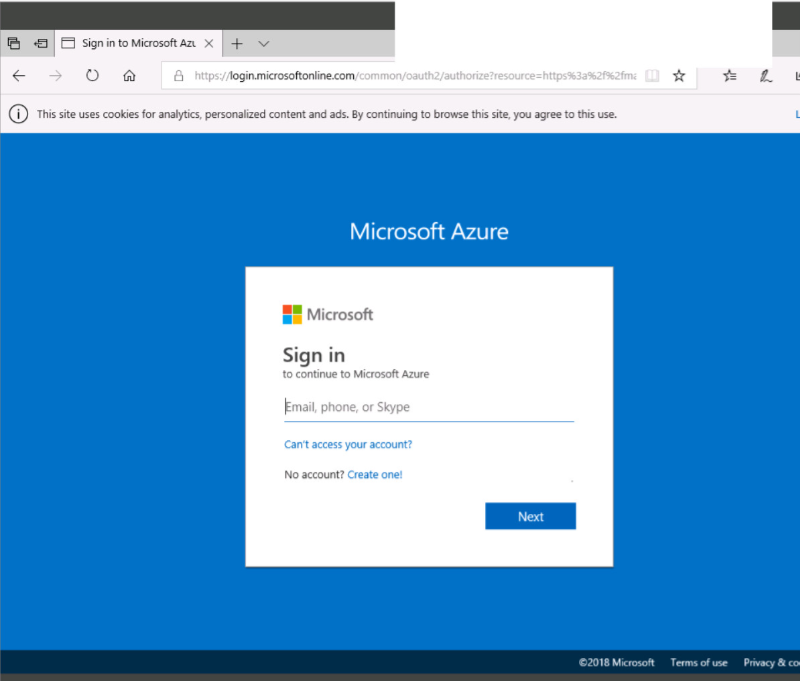
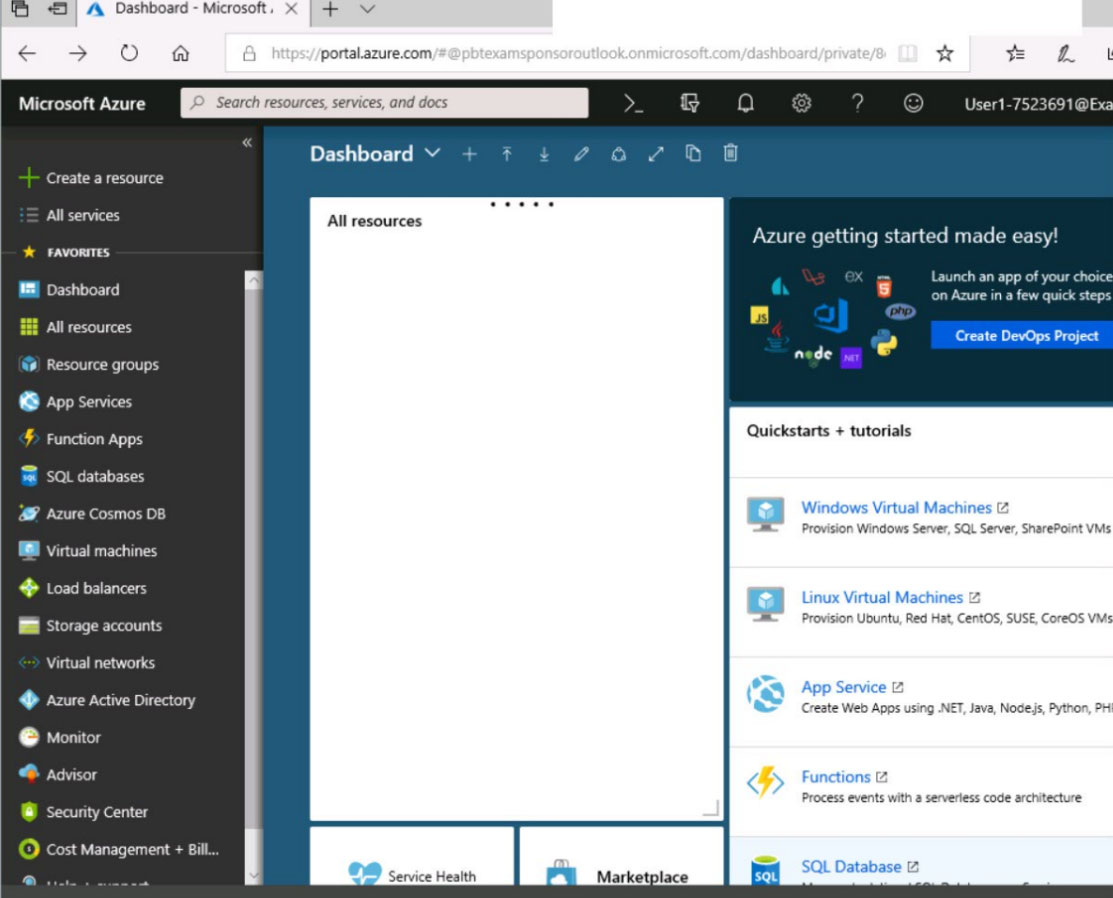
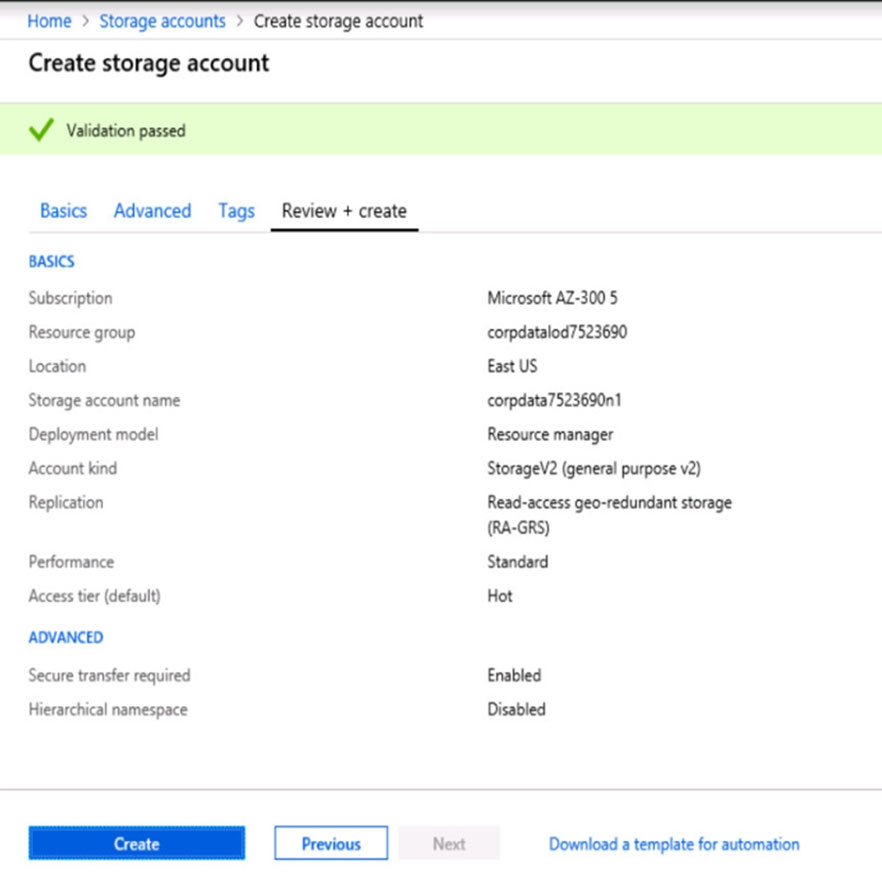
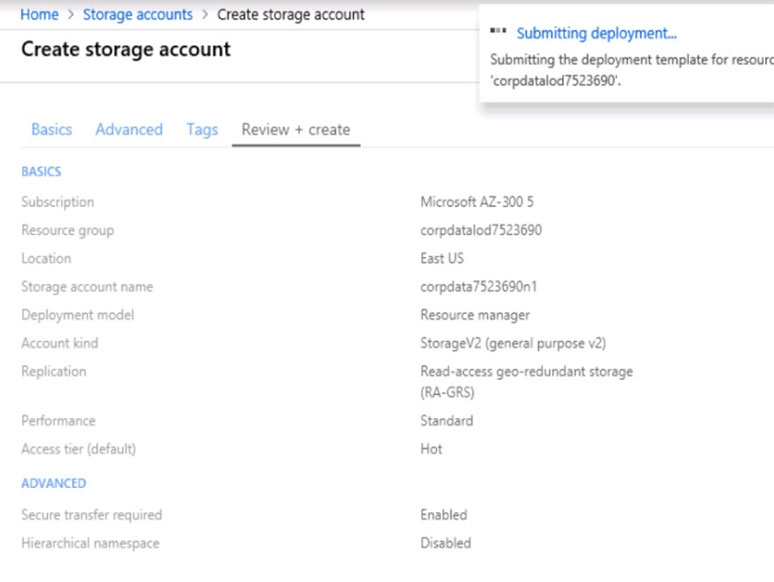
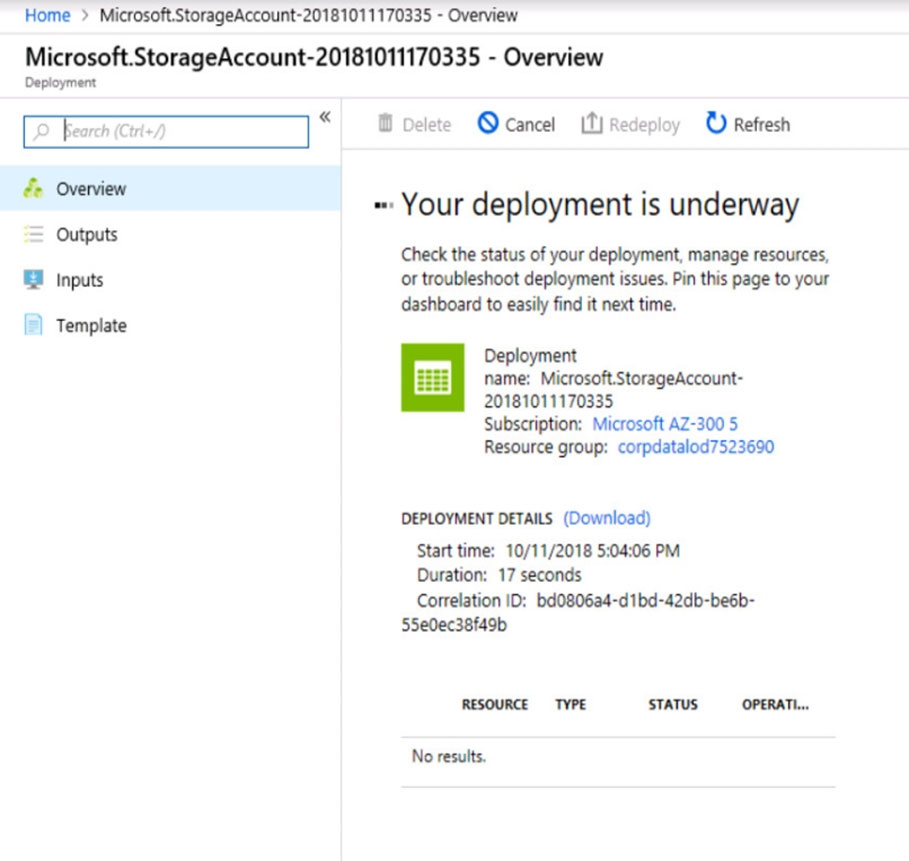
When you are finished performing all the tasks, click the `˜Next' button. Note that you cannot return to the lab once you click the `˜Next' button. Scoring occur in the background while you complete the rest of the exam. Overview - The following section of the exam is a lab. In this section, you will perform a set of tasks in a live environment. While most functionality will be available to you as it would be in a live environment, some functionality (e.g., copy and paste, ability to navigate to external websites) will not be possible by design. Scoring is based on the outcome of performing the tasks stated in the lab. In other words, it doesn't matter how you accomplish the task, if you successfully perform it, you will earn credit for that task. Labs are not timed separately, and this exam may have more than one lab that you must complete. You can use as much time as you would like to complete each lab. But, you should manage your time appropriately to ensure that you are able to complete the lab(s) and all other sections of the exam in the time provided. Please note that once you submit your work by clicking the Next button within a lab, you will NOT be able to return to the lab. To start the lab - You may start the lab by clicking the Next button. Your company plans to store several documents on a public website. You need to create a container named bios that will host the documents in the corpdata7523690n1 storage account. The solution must ensure anonymous access and must ensure that users can browse folders in the container. What should you do from the Azure portal?
A company hosts virtual machines (VMs) in an on-premises datacenter and in Azure. The on-premises and Azure-based VMs communicate using ExpressRoute. The company wants to be able to continue regular operations if the ExpressRoute connection fails. Failover connections must use the Internet and must not require Multiprotocol Label Switching (MPLS) support. You need to recommend a solution that provides continued operations. What should you recommend?
A. Increase the bandwidth of the existing ExpressRoute connection.
B. Increase the bandwidth for the on-premises internet connection.
C. Set up a VPN connection.
D. Set up a second ExpressRoute connection.
HOTSPOT - You have an Azure Active Directory (Azure AD) tenant that contains the user groups shown in the following table.You enable self-service password reset (SSPR) for Group1. You configure the Notifications settings as shown in the following exhibit.
For each of the following statements, select Yes if the statement is true. Otherwise, select No. NOTE: Each correct selection is worth one point. Hot Area:
HOTSPOT - You have an Azure subscription that contains the storage account shown in the following table.For each of the following statements, select Yes if the statement is true. Otherwise, select No. NOTE: Each correct selection is worth one point. Hot Area:
You have a virtual network named VNet1 as shown in the exhibit. (Click the Exhibit tab.)No devices are connected to VNet1. You plan to peer VNet1 to another virtual network named VNet2 in the same region. VNet2 has an address space of 10.2.0.0/16. You need to create the peering. What should you do first?
A. Add a gateway subnet to VNet1.
B. Create a subnet on VNet1 and VNet2
C. Modify the address space of VNet1
D. Configure a service endpoint on VNet2
You are developing an application that will enable users to download content from an Azure Storage account. The users must only be able to download the content for a period of seven days. You need to recommend an authentication solution to access the storage account. What should you include in the recommendation?
A. shared access signature (SAS) tokens
B. identity-based authentication that uses Active Directory Domain Services (AD DS)
C. storage access key
D. identity-based authentication that uses Azure Active Directory (Azure AD)
HOTSPOT - You need to identify the storage requirements for Contoso. For each of the following statements, select Yes if the statement is true. Otherwise, select No. NOTE: Each correct selection is worth one point. Hot Area:
HOTSPOT - You have an Azure subscription named Subscription1. Subscription1 contains the virtual machines in the following table:Subscription1 contains a virtual network named VNet1 that has the subnets in the following table.
VM3 has multiple network adapters, including a network adapter named NIC3. IP forwarding is enabled on NIC3. Routing is enabled on VM3. You create a route table named RT1 that contains the routers in the following table.
You apply RT1 to Subnet1 and Subnet2. For each of the following statements, select Yes if the statement is true. Otherwise, select No. NOTE: Each correct selection is worth one point. Hot Area:
HOTSPOT - You have an Azure subscription that contains the Azure SQL servers shown in the following table.The subscription contains the elastic pools shown in the following table.
The subscription contains the Azure SQL databases shown in the following table.
For each of the following statements, select Yes if the statement is true. Otherwise, select No. NOTE: Each correct selection is worth one point. Hot Area:
SIMULATION - Click to expand each objective. To connect to the Azure portal, type https://portal.azure.com in the browser address bar.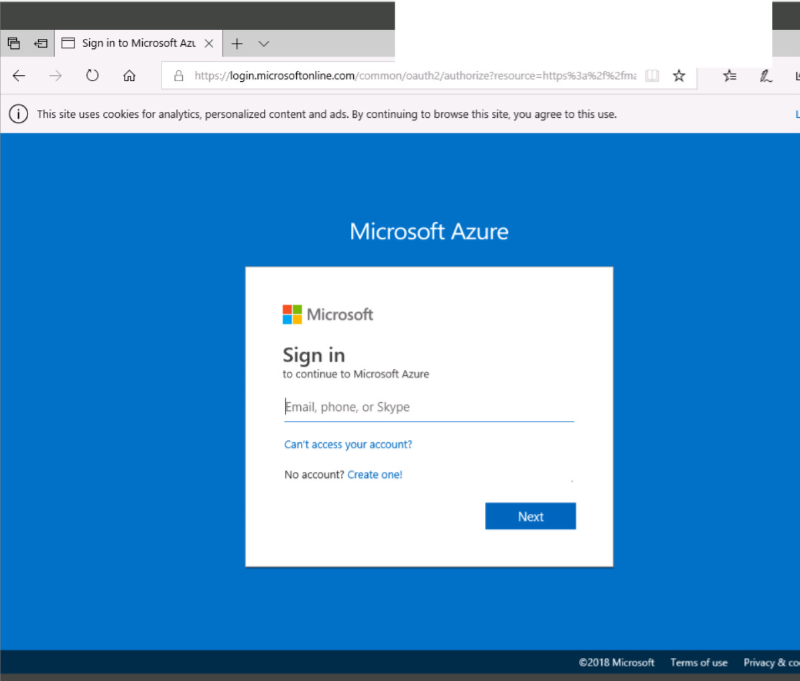
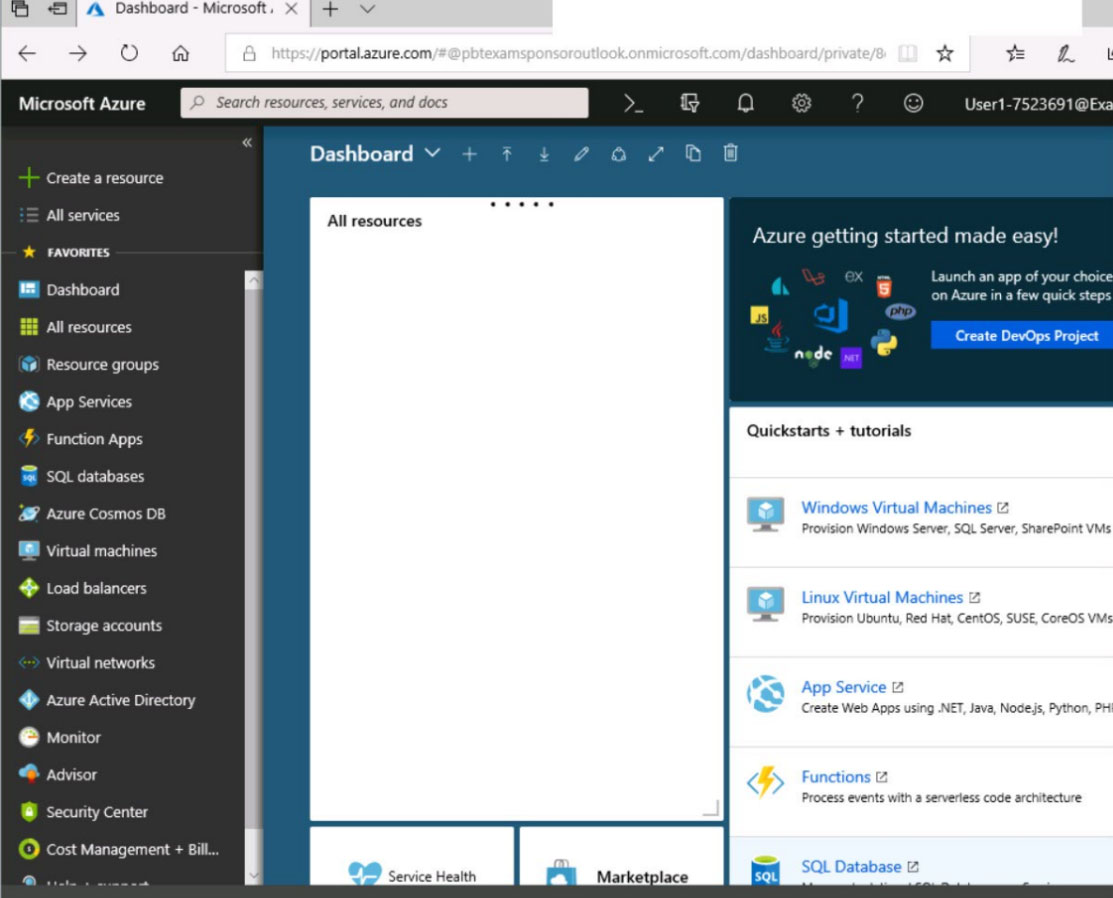
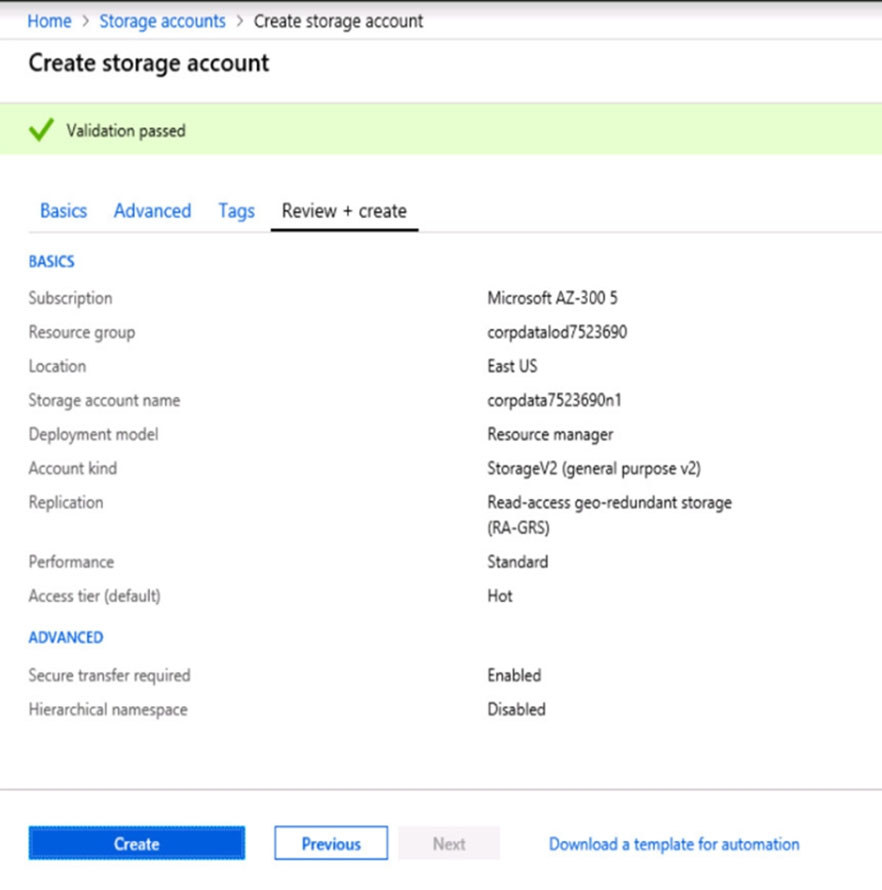
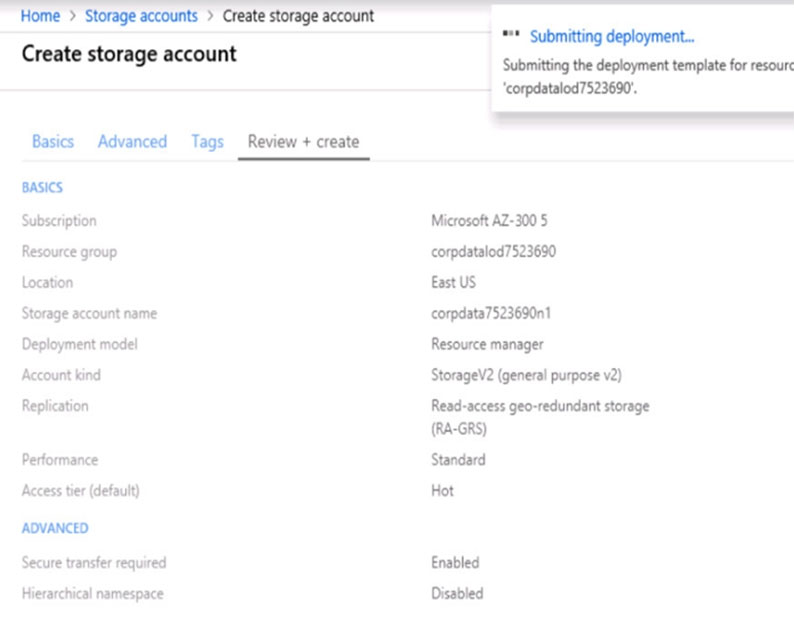
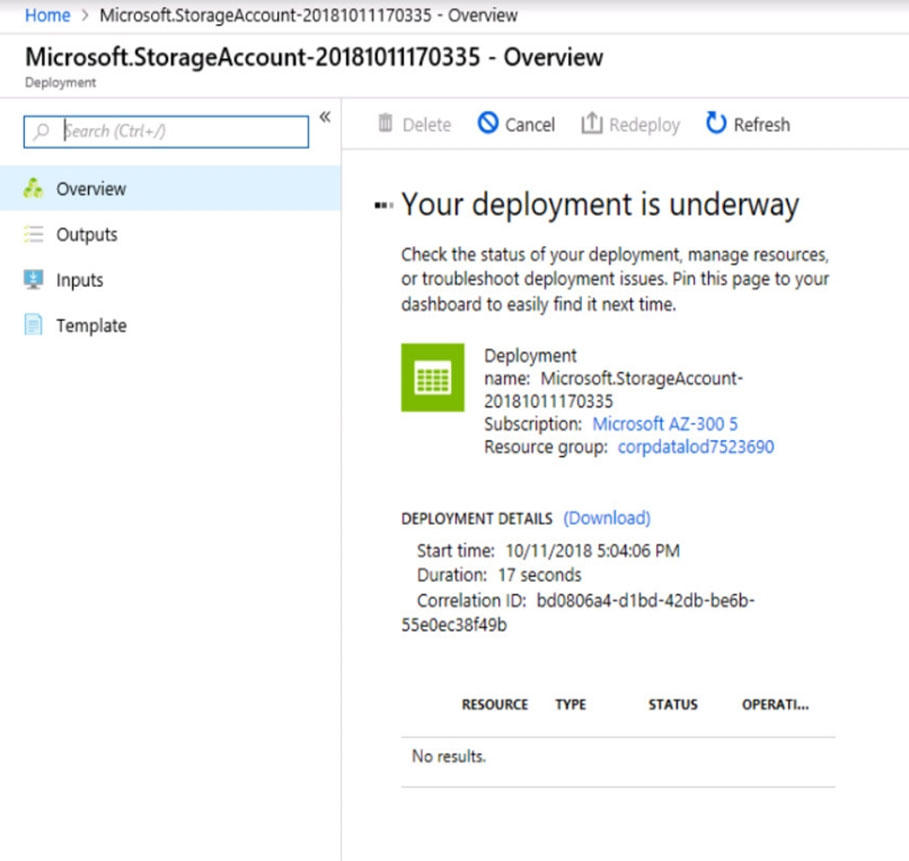
When you are finished performing all the tasks, click the `˜Next' button. Note that you cannot return to the lab once you click the `˜Next' button. Scoring occur in the background while you complete the rest of the exam. Overview - The following section of the exam is a lab. In this section, you will perform a set of tasks in a live environment. While most functionality will be available to you as it would be in a live environment, some functionality (e.g., copy and paste, ability to navigate to external websites) will not be possible by design. Scoring is based on the outcome of performing the tasks stated in the lab. In other words, it doesn't matter how you accomplish the task, if you successfully perform it, you will earn credit for that task. Labs are not timed separately, and this exam may have more than one lab that you must complete. You can use as much time as you would like to complete each lab. But, you should manage your time appropriately to ensure that you are able to complete the lab(s) and all other sections of the exam in the time provided. Please note that once you submit your work by clicking the Next button within a lab, you will NOT be able to return to the lab. To start the lab - You may start the lab by clicking the Next button. You need to deploy an Azure virtual machine named VM1004a based on an Ubuntu Server image, and then to configure VM1004a to meet the following requirements: - The virtual machines must contain data disks that can store at least 15 TB of data - The data disk must be able to provide at least 2,000 IOPS - Storage costs must be minimized What should you do from the Azure portal?
SIMULATION - Click to expand each objective. To connect to the Azure portal, type https://portal.azure.com in the browser address bar.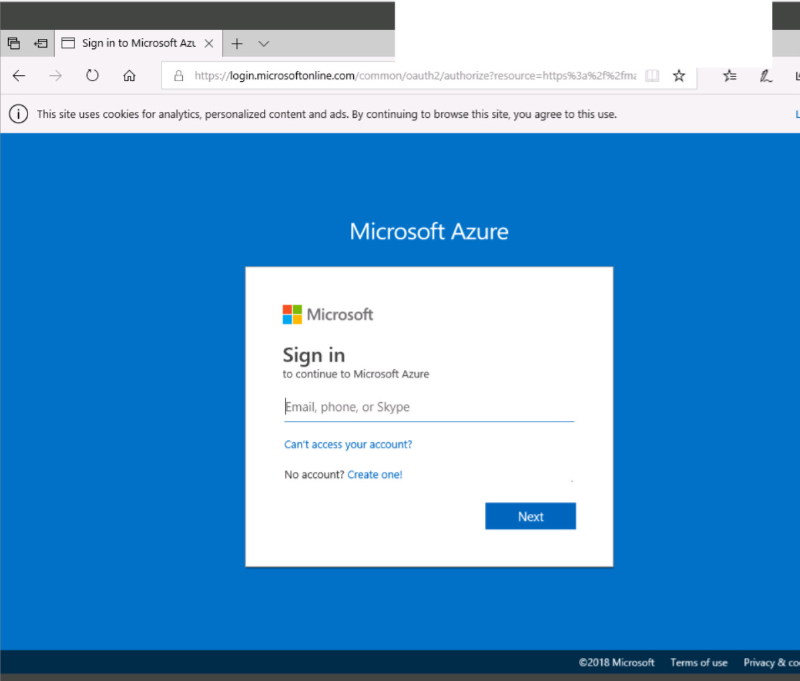
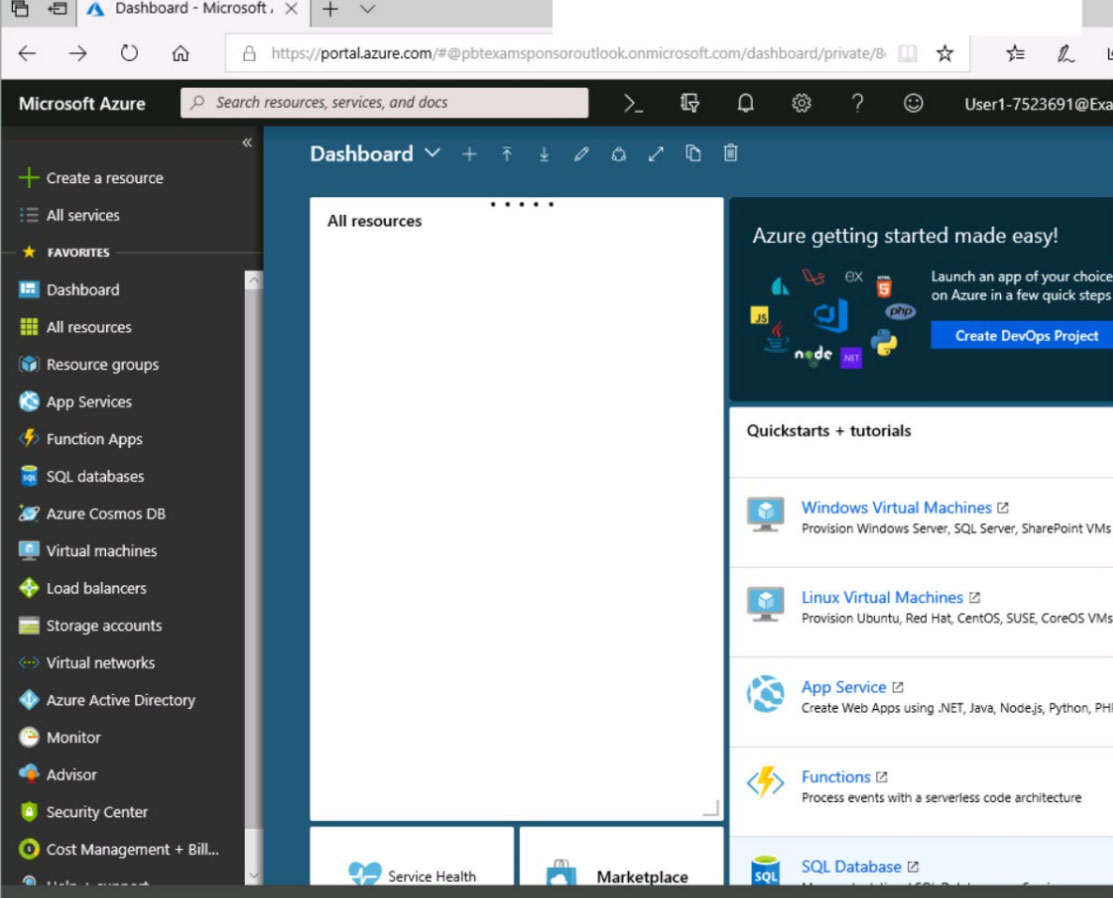
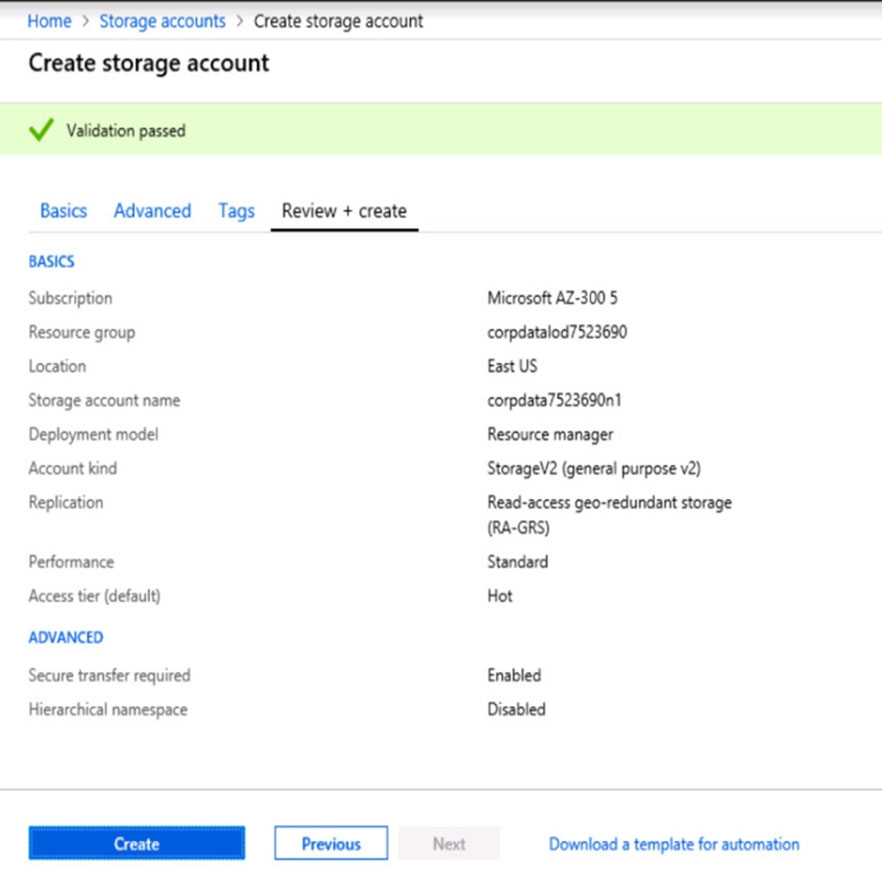
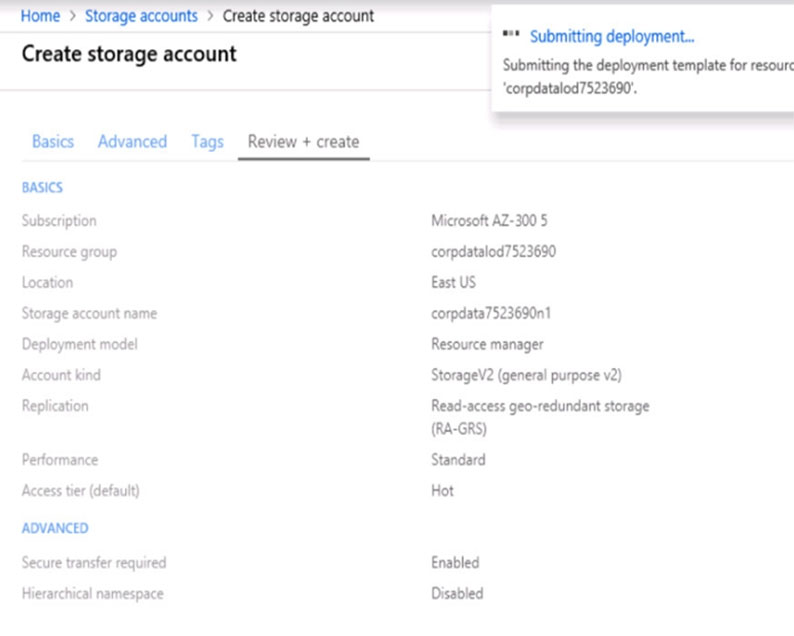
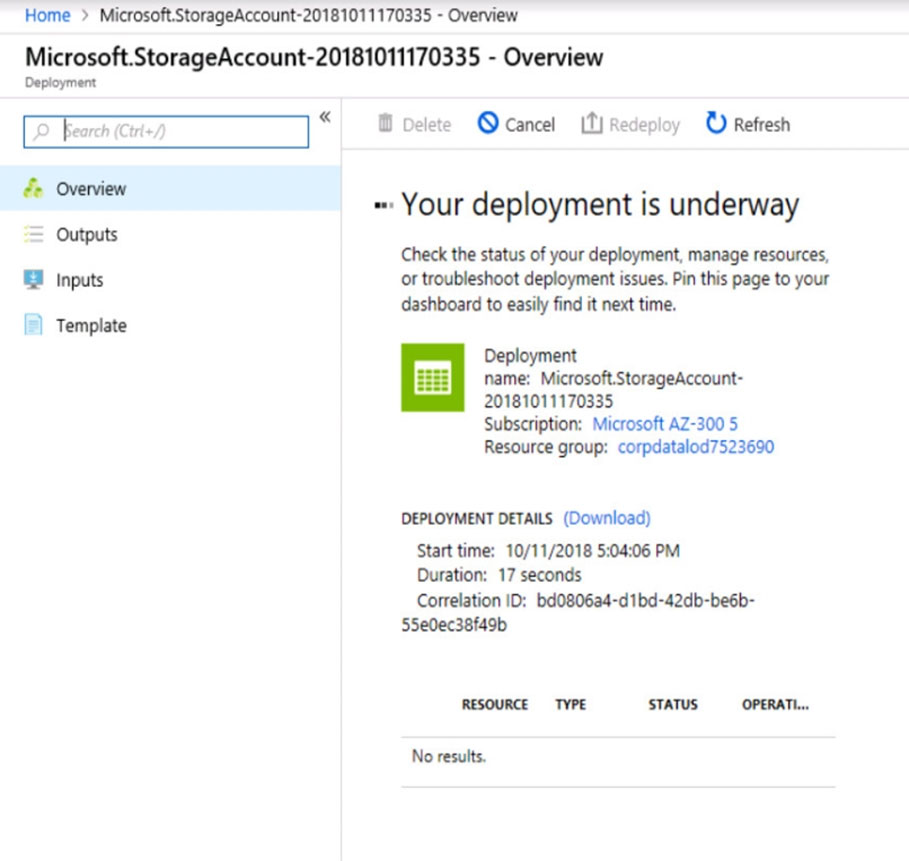
When you are finished performing all the tasks, click the `˜Next' button. Note that you cannot return to the lab once you click the `˜Next' button. Scoring occur in the background while you complete the rest of the exam. Overview - The following section of the exam is a lab. In this section, you will perform a set of tasks in a live environment. While most functionality will be available to you as it would be in a live environment, some functionality (e.g., copy and paste, ability to navigate to external websites) will not be possible by design. Scoring is based on the outcome of performing the tasks stated in the lab. In other words, it doesn't matter how you accomplish the task, if you successfully perform it, you will earn credit for that task. Labs are not timed separately, and this exam may have more than one lab that you must complete. You can use as much time as you would like to complete each lab. But, you should manage your time appropriately to ensure that you are able to complete the lab(s) and all other sections of the exam in the time provided. Please note that once you submit your work by clicking the Next button within a lab, you will NOT be able to return to the lab. To start the lab - You may start the lab by clicking the Next button. Another administrator reports that she is unable to configure a web app named corplod10217507n3 to prevent all connections from an IP address of 11.0.0.11. You need to modify corplod10217507n3 to successfully prevent the connections from the IP address. The solution must minimize Azure-related costs. What should you do from the Azure portal?
You have an Azure Service Bus and two clients named Client1 and Client2. You create a Service Bus queue named Queue1 as shown in the exhibit. (Click the Exhibit tab.)Client1 send messages to Queue1 as shown in the following table.
Client2 reads the messages from Queue1 at 12:01:05. How will the messages be presented to Client2?
A. Client2 will read three messages in the following order: M1, M2, and then M3.
B. Client2 will read three messages in the following order: M3, M1, and then M2.
C. Client2 will read four messages in the following order: M3, M1, M2 and then M3.
D. Client2 will read four messages in the following order: M3, M2, M1 and then M3.
HOTSPOT - You need to identify the storage requirements for Contoso. For each of the following statements, select Yes if the statement is true. Otherwise, select No. NOTE: Each correct selection is worth one point. Hot Area:
You have an Azure subscription that contains 10 virtual machines. You need to ensure that you receive an email message when any virtual machines are powered off, restarted, or deallocated. What is the minimum number of rules and action groups that you require?
A. three rules and three action groups
B. one rule and one action group
C. three rules and one action group
D. one rule and three action groups
HOTSPOT - You have an Azure subscription named Subscription1 that contains a virtual network named VNet1. You add the users in the following table.Which user can perform each configuration? To answer, select the appropriate options in the answer area. NOTE: Each correct selection is worth one point. Hot Area:
You have an Azure subscription. You create a custom role in Azure by using the following Azure Resource Manager template.You assign the role to a user named User1. Which action can User1 perform?
A. Delete virtual machines.
B. Create resource groups.
C. Create virtual machines.
D. Create support requests.
DRAG DROP - You have an Azure Active Directory (Azure AD) tenant that has the initial domain name. You have a domain name of contoso.com registered at a third-party registrar. You need to ensure that you can create Azure AD users that have names containing a suffix of @contoso.com. Which three actions should you perform in sequence? To answer, move the appropriate cmdlets from the list of cmdlets to the answer area and arrange them in the correct order. Select and Place:
You are implementing authentication for applications in your company. You plan to implement self-service password reset (SSPR) and multifactor authentication (MFA) in Azure Active Directory (Azure AD). You need to select authentication mechanisms that can be used for both MFA and SSPR. Which two authentication methods should you use? Each correct answer presents a complete solution. NOTE: Each correct selection is worth one point.
A. Authenticator app
B. Email addresses
C. App passwords
D. Short Message Service (SMS) messages
E. Security questions
HOTSPOT - A company runs multiple Windows virtual machines (VMs) in Azure. The IT operations department wants to apply the same policies as they have for on-premises VMs to the VMs running in Azure, including domain administrator permissions and schema extensions. You need to recommend a solution for the hybrid scenario that minimizes the amount of maintenance required. What should you recommend? To answer, select the appropriate options in the answer area. NOTE: Each correct selection is worth one point. Hot Area:
HOTSPOT - You plan to deploy five virtual machines to a virtual network subnet. Each virtual machine will have a public IP address and a private IP address. Each virtual machine requires the same inbound and outbound security rules. What is the minimum number of network interfaces and network security groups that you require? To answer, select the appropriate options in the answer area. NOTE: Each correct selection is worth one point. Hot Area:
Note: This question is part of series of questions that present the same scenario. Each question in the series contains a unique solution that might meet the stated goals. Some question sets might have more than one correct solution, while others might not have a correct solution. After you answer a question in this section, you will NOT be able to return to it. As a result, these questions will not appear in the review screen. You have an Azure subscription named Subscription1. Subscription1 contains a resource group named RG1. RG1 contains resources that were deployed by using templates. You need to view the date and time when the resources were created in RG1. Solution: From the Subscription blade, you select the subscription, and then click Resource providers. Does this meet the goal?
A. Yes
B. No
DRAG DROP - You have an on-premises file server named Server1 that runs Windows Server 2016. You have an Azure subscription that contains an Azure file share. You deploy an Azure File Sync Storage Sync Service, and you create a sync group. You need to synchronize files from Server1 to Azure. Which three actions should you perform in sequence? To answer, move the appropriate actions from the list of actions to the answer area and arrange them in the correct order. Select and Place:
After you answer a question in this section, you will NOT be able to return to it. As a result, these questions will not appear in the review screen. You have an Azure Active Directory (Azure AD) tenant named contoso.com. A user named Admin1 attempts to create an access review from the Azure Active Directory admin center and discovers that the Access reviews settings are unavailable. Admin1 discovers that all the other Identity Governance settings are available. Admin1 is assigned the User administrator, Compliance administrator, and Security administrator roles. You need to ensure that Admin1 can create access reviews in contoso.com. Solution: You create an access package. Does this meet the goal?
A. Yes
B. No
HOTSPOT - You have Azure Storage accounts as shown in the following exhibit.Use the drop-down menus to select the answer choice that completes each statement based on the information presented in the graphic. NOTE: Each correct selection is worth one point. Hot Area:
You create a new Azure subscription. You create a resource group named RG1. In RG1, you create the resources shown in the following table.You need to configure an encrypted tunnel between your on-premises network and VNET1. Which two additional resources should you create in Azure? Each correct answer presents part of the solution. NOTE: Each correct selection is worth one point.
A. a VPN gateway
B. a site-to-site connection
C. a point-to-site configuration
D. a VNet-to-VNet connection
E. a local network gateway
Free Access Full AZ-303 Practice Questions Free
Want more hands-on practice? Click here to access the full bank of AZ-303 practice questions free and reinforce your understanding of all exam objectives.
We update our question sets regularly, so check back often for new and relevant content.
Good luck with your AZ-303 certification journey!



